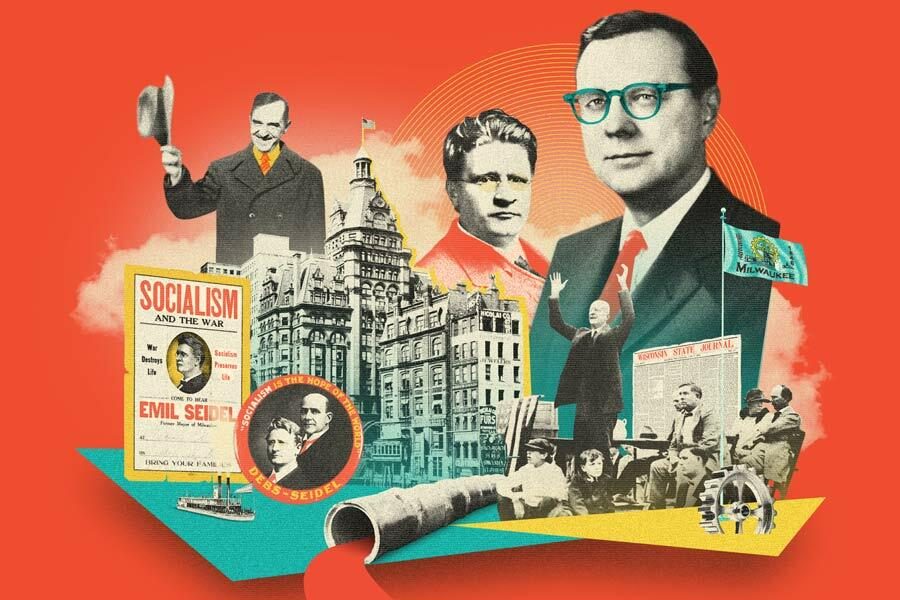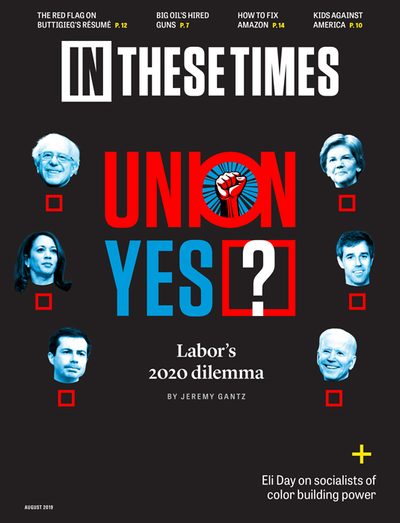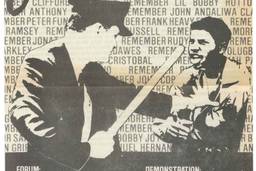How a Sewer Socialist City May Push Democrats Left in 2020
When presidential hopefuls arrive in Milwaukee for the 2020 Democratic National Convention, they must choose whether to embrace the city’s socialist history, or run from it.
Lindsey Anderson

Milwaukee Mayor Tom Barrett announced March 11 that, for the first time in its history, the city will host the 2020 Democratic National Convention.
In some ways, the choice was obvious. Wisconsin is a swing state whose demographics — in terms of race, ethnicity, income, education and neighborhood composition — closely reflect those of the United States as a whole. And the memory of Hillary Clinton’s 2016 snub is still fresh in the minds of many Midwesterners: During Clinton’s presidential campaign, her team (led by Robby Mook) decided that Wisconsin was such a safe Democratic stronghold, Clinton wouldn’t need to visit. She lost Wisconsin by around 23,000 votes.
The Democratic Party has clearly learned from this 2016 mistake as it considers strategies to turn battlegrounds like Wisconsin blue. But one can also make the case that, in choosing Milwaukee, the party is honoring the city’s unique political history. Milwaukee is the only major U.S. city to have elected three socialist mayors: Emil Seidel, Daniel Hoan and Frank Zeidler. They held office for a collective 38 years (between 1910 and 1960) and helped earn Milwaukee a reputation for being, as Time magazine reported in 1936, “perhaps the best governed city in the U.S.”
Mark Jefferson, executive director of the Republican Party of Wisconsin, seized upon this history as an opportunity to redbait: “No city in America has stronger ties to socialism,” he said in a statement about the 2020 Democratic convention. “And with the rise of Bernie Sanders and the embrace of socialism by its newest leaders, the American Left has come full circle. It’s only fitting the Democrats would come to Milwaukee.”
Jefferson was being snarky, but he’s arguably correct. Nearly all the Democratic presidential candidates have included policies in their campaign platforms that harken back to the city’s legacy of “sewer socialist” mayors (a phrase coined in 1932 that refers to the superlative public works projects created by Milwaukee socialists). Milwaukeeans didn’t seem particularly bothered by the term, though. “Yes, we wanted sewers in the workers’ houses,” Mayor Emil Seidel wrote in his 1944 memoirs, “but we wanted much, oh, so very much more than sewers. We wanted our workers to have pure air; we wanted them to have sunshine; we wanted planned homes; we wanted living wages; we wanted recreation for young and old; we wanted vocational education; we wanted a chance for every human being to be strong and live a life of happiness.”
Tom Perez, chair of the Democratic National Committee, seemed to suggest that Milwaukee’s progressive politicians embodied the party’s best impulses, stating at the March 11 press conference, “Where you hold a convention is a very strong statement of your values … of who we are as a party, and who and what we’re fighting for.”
Perez, whose wife grew up in the Milwaukee suburbs, is likely well aware of the city’s socialist history. His own politics around socialism are less clear: A well-respected labor secretary under President Barack Obama, Perez beat out the Left’s preferred candidate for DNC chair, Congressional Progressive Caucus co-chair Keith Ellison, who was endorsed by the Democratic Socialists of America (DSA), the Progressive Democrats of America, Friends of the Earth Action, Unite Here and many other progressive organizations.
The Milwaukee chapter of the DSA, for its part, intends to leverage the city’s history to elevate democratic socialists — in particular, Bernie Sanders. They’re even thinking of leading a series of socialist history tours for politicians and delegates, with stops at local landmarks such as Turner Hall and the Riverwest Public House. In the meantime, residents continue to express interest in joining the chapter, which has seen its membership surge since the 2016 election.
As more and more Democratic voters, especially millennials, identify as democratic socialists, it feels momentous that Milwaukee, with its proud “sewer socialist” past, will be hosting the Democratic convention. Candidates vying for the nomination will have to ask themselves: Will they embrace socialism, or run from it?
The socialist movement in Milwaukee has its beginnings in the mid-1800s, when German immigrants began moving to the city in droves. Many of them had been vocal supporters of the revolutions of 1848 — a series of failed uprisings led by middle-class people who wanted to bring democracy to Europe’s remaining monarchies — and they brought their liberal ideas with them as they settled in Brew City. Yet those ideas may never have gained real traction if it weren’t for German-born Milwaukee socialists, such as the socialist newspaper editor Paul Grottkau, who helped spearhead a citywide strike in the spring of 1886.
In 1886, Grottkau was among the founders of Milwaukee’s Eight-hour League, a group of workers dedicated to shorter workdays. That same year, Polish laborers began meeting at a local church to organize a general strike in protest of their 10-hour workdays. Together, they recruited thousands of people to join their cause.
On May 2, around 14,500 protesters marched through the streets of Milwaukee, chanting and waving banners. Tens of thousands of spectators turned out. According to a 1910 article in the Milwaukee Free Press, “Reports came in thick and fast that in all parts of the city uprisings were taking place and that large bodies of laboring men were marching toward the manufacturing plants intent on rioting and destruction.”
Afraid that the local police would not be able to control the crowds, Wisconsin Gov. Jeremiah Rusk dispatched the state militia to subdue them. By the time his troops reached the city, protesters had shut down every major factory in the metro area, save for the Bay View Rolling Mills, whose managers had insisted on keeping it open. On May 5, around 1,500 protesters — including many women and children who had joined the strikers — marched toward the factories, intent on convincing the workers there to shut them down.
When the marchers neared the militia, they stopped. But Major George P. Traeumer, anticipating violence from the protesters, ordered the soldiers to fire at will. At least five people were killed, including a 13-year-old, and many more injured. The bloody retaliation brought the 1886 strike to an abrupt end. In the months that followed, the public began to empathize more with the socialists who helped organize the strike.
When Grottkau was convicted of inciting a riot and sentenced to a year in prison, he leveraged all the media attention he was receiving to announce a run for mayor of Milwaukee. He didn’t win, but he helped popularize working-class causes like public ownership of utilities and the elimination of graft in local government, leading the way for the successful electoral campaigns of other socialists.
In 1904, Emil Seidel became one of nine socialists to join Milwaukee’s city council as an alderman. In 1910, Seidel became the first socialist to win a mayoral race in a major U.S. city, with about 6,500 more votes than the next candidate. That same year, socialists carried 14 of the city’s 23 wards.
Seidel became interested in progressive politics and Marxism while studying woodcarving in Berlin. From 1910-12, he established the first public works office in the city. Seidel also closed many of Milwaukee’s gambling parlors and brothels and created a public parks system. And he infuriated both Democrats and Republicans by cracking down on political corruption.
Dems and the GOP collaborated to beat out Seidel in 1912 by jointly endorsing a different candidate, but many other socialists managed to hold onto public office and continued to push for progressive reform. One of them was Daniel Hoan, who was elected Milwaukee’s city attorney in 1910. While holding that office, he pushed the country’s first worker’s compensation law through the state legislature and helped Seidel reduce corruption in the local government by making their processes streamlined and transparent. Hoan gained enough popular support to mount a successful mayoral campaign in 1916 and held the office for 24 years.
Hoan established a public bus system and the nation’s first public housing project and successfully steered Milwaukee toward public ownership of its stone quarry, streetlights, sewage disposal system and water purification system. Hoan created a program to make textbooks free for local students and another to administer free vaccines. He is still widely considered one of the most altruistic mayors in American history.
The most recent Milwaukee mayoral socialist, Frank Zeidler, held office from 1948 to 1960. His biggest achievement as mayor was incorporating many suburbs into the city, nearly doubling Milwaukee’s size and tax base (which forestalled the urban blight that had begun to plague cities that failed to incorporate their suburbs, like St. Louis, around the same time). Zeidler was also a staunch advocate for civil rights legislation and helped push for the establishment of the University of Wisconsin-Milwaukee.
Near the end of his time in office, Zeidler released an “Inner Core Report,” a study describing Milwaukee’s inner-city conditions with a detailed plan to improve the city’s increasingly strained race relations. The suggestions, which could have helped prevent much of the redlining that would eventually transform Milwaukee into one of the most segregated cities in the United States, were largely ignored by his successor.
The greater legacy of Milwaukee’s socialist politicians is still palpable today. Milwaukee’s public parks system is one of the most extensive in the country. Its public beaches (in the early 1900s, wealthy Milwaukeeans bought up most of the city’s lakefront property — socialists then poured sand and soil into the harbor in front of their land to create several public beaches) draw crowds every year.
Milwaukee’s socialists also seem to have influenced later generations of progressive politicians, such as Robert La Follette, a left-wing Republican who became governor of Wisconsin and founded The Progressive magazine.
Current members of Milwaukee DSA certainly see themselves as present-day sewer socialists. Member Brandon Payton-Carrillo, 35, says he draws inspiration from the pragmatic approach to local government adopted by Seidel, Hoan and Zeidler. Payton-Carrillo hopes his chapter can leverage the 2020 DNC convention to shine a spotlight on DSA campaigns like Get the Lead Out, a coalition formed to pressure Milwaukee politicians to remove lead from the city’s drinking water. “That bottom-up grassroots experience is the foundation of Milwaukee socialism,” he says.
When Bernie Sanders and the rest of the Democratic candidates arrive in Milwaukee in July 2020, the world will be waiting to see how they articulate their vision for a better future. If any of them point to Milwaukee’s sewer socialists, and the way they governed their city, the world will be listening.





